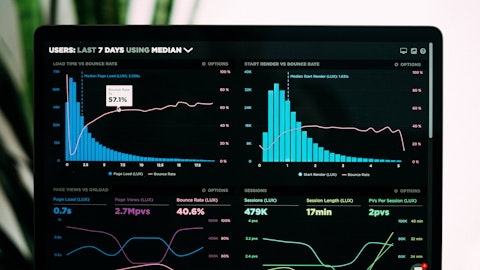ImmunoGen, Inc. (NASDAQ:IMGN) Q3 2023 Earnings Call Transcript November 2, 2023
ImmunoGen, Inc. beats earnings expectations. Reported EPS is $0.1, expectations were $0.02.
Operator: Good morning, ladies and gentlemen, and welcome to ImmunoGen’s Third Quarter 2023 Financial and Operating Results Conference Call. Today’s conference is being recorded. At this time, I’d like to turn the call over to Anabel Chan, Head of Investor Relations. Please go ahead.
Anabel Chan: Good morning, and thank you for joining today’s call. Earlier today, we issued a press release that includes a summary of our recent operating progress and third quarter financial results. This press release, a recording of this call and an updated corporate deck can be found under the Investors & Media section of our website at immunogen.com. With me today are Mark Enyedy, our President and CEO; and Isabel Kalofonos, our Chief Commercial Officer; Michael Vasconcelles, our EVP of Research, Development and Medical Affairs; and Lauren White, our CFO. During today’s call, we will review recent progress for the business, our financial results and highlight upcoming anticipated events. We will be making forward-looking statements based on our current expectations and beliefs.
These statements are subject to risks and uncertainties, and our actual results may differ materially. Please consult the risks outlined in our press release issued this morning in the Risk Factors section of our most recent annual report on Form 10-K and quarterly report on Form 10-Q and in our other SEC filings, which are available at sec.gov and immunogen.com. With that, I’ll turn the call over to Mark.
Mark Enyedy: Thanks, Anabel. Good morning, everyone, and thank you for joining us today. This has been another productive quarter for ImmunoGen, highlighted by the ongoing exemplary execution of the commercial launch for ELAHERE in the U.S., progress made towards both geographic and label expansion for ELAHERE and the advancement of our portfolio. Starting with the commercial update. We delivered a strong quarter with ELAHERE generating just over $105 million in net sales, resulting in over $210 million in revenue year-to-date, which puts us on track with one of the most successful oncology launches in a decade. This performance is driven by a combination of factors, including strong adoption of FR alpha testing and corresponding product ordering in a population with high unmet need with robust uptake in our labeled indication across both academic and community settings as well as discretionary use in a broader patient population based on NCCN guidelines, including use of ELAHERE monotherapy in later lines and in combination with bevacizumab.
Rapid achievement of broad access and reimbursement increased breadth and depth of prescribing, driven in part by penetration into priority accounts and increased awareness of ELAHERE driven by engagement by our medical affairs team the compelling data for MIRASOL and positive physician and patient experiences. Looking forward, we expect continued growth, albeit at a moderating pace supported by continued focus on execution with respect to our launch imperatives, a strong and growing prescriber base, and ELAHERE becoming the medicine of choice for patients with FR alpha-positive disease. Isabel will have more to say about our current and future business in a moment. As we aim to expand the geographic footprint for ELAHERE and look to bring this novel ADC to patients globally, we are pleased to share that the EMA has accepted our marketing application to support potential European approval and our partner of Huadong received acceptance of the NDA in China.
In addition, we announced a collaboration with Takeda to develop and commercialize ELAHERE in Japan and submitted a supplemental BLA to FDA to support the conversion of the accelerated approval of ELAHERE to full approval here in the U.S. In step with our commercial efforts, we are advancing the broader ELAHERE development program to support low expansion into platinum-sensitive disease and to position ELAHERE as the combination agent of choice in ovarian cancer. In this context, we are pleased to share that our PICCOLO Phase II trial evaluating ELAHERE monotherapy in platinum-sensitive ovarian cancer has met its primary endpoint of objective response rate. Noting that PICCOLO is ongoing and patients are continuing to receive ELAHERE, to date, we’ve observed no new safety signals in this patient population.
These data represent an important step towards expanding ELAHERE into the platinum-sensitive setting, and Mike will discuss these data in more detail shortly. Turning briefly to the rest of the pipeline. In our second pivotal program, PVEK, we look forward to reporting data from our PVEK triplet in frontline AML later this year at ASH, and we are on track with top line data from the pivotal frontline de novo cohort in BPDCN expected in 2024. In addition, IMGC936 and IMGN151 are progressing, and we remain focused on reinvesting in our research capabilities and expanding our pipeline. Lastly, I’m pleased to report that we strengthened our leadership team with the recent appointment of Lauren White as Chief Financial Officer; and commensurate with our expanding commitment to continued innovation of our ADC platform, we welcome Heather Hewett as Chief Scientific Officer.
With an experienced management team in place and a strong balance sheet, we are well positioned to expand the commercial opportunity for ELAHERE and in parallel, continuing to advance and invest in our pipeline. With that, I’ll turn the call over to Isabel to cover our commercial progress. Isabel?
Isabel Kalofonos: Thank you, Mark. The commercial team build upon the strong momentum established in the first half of the year and delivered another strong quarter as we continue to make progress towards positioning ELAHERE as the standard of care portfolio receptor also positive ovarian cancer. In the third quarter, we saw a 35% sequential growth versus the prior quarter. We are pleased with our performance since launch and believe it is due to a combination of 4 key factors, including: a strong adoption in an area of high unmet need; rapid access and reimbursement coverage; the solid execution of our commercial customer-facing teams; and increased physician experience and awareness or the benefits this novel treatment brings to patients with advanced ovarian cancer.
Let me take some time to address each of these key factors in more detail. First, let me share some insight into the dynamics observed while launching into an area of high unmet need. Starting with the identification of patients, almost a year into our launch, we have seen the overall awareness for FR alpha testing increased and rapid adoption of the FORWARD I diagnostics being incorporated as a standard component of the initial panel conducted on newly diagnosed patients and for patients moving to the next line of therapy. Our market research indicates that over 80% of physicians are familiar with FR alpha testing, up from a baseline of under 50% at the time of approval. It is becoming the standard of care that will enable oncologists to rapidly incorporate ELAHERE into the treatment decision, needless to say, testing has not been to adoption.
Since launch, we have endeavored to provide the market with a number of tests conducted at our 3 largest centralized labs. As of the end of the quarter, that number stood at 16,000 tests. However, with approximately 40 labs now certified to branded tests, our visibility into the number of tests performed has decreased and will discontinue reporting on the metrics on subsequent calls. We will, however, continue to report the foliate receptor alpha positive rate which remains between 35% and 40%, in line with our expectations. Looking at patient adoption. ELAHERE addresses a high unmet need among platinum-resistant ovarian cancer patients. As indicated by the initial strong uptake in later life with the need has been great. In the first quarter, the vast majority of patients were from later lines of therapy.
And as the launch has progressed, will shift to earlier lines. This is low and steady trend, and we expect this to become a key driver of future growth. Moving to our second key factor, access and investment. Driven by the effort of our alpha team, we secured coverage policies aligned to our level for over 95% of both Medicare and commercial lives within the first 7 months of launch, exceeding another benchmark, ADC. In addition, with the inclusion of ELAHERE NCCN guidelines, we have seen utilization in a broad population, including the use of monotherapy related lines and in combination with bevacizumab in low, medium and high FR alpha presentations. Third, a strong execution by our commercial team driving adoption of ELAHERE. Our customer-facing team have been highly active since launch.
During the third quarter, they continues to engage priority targets to broaden our reach resulting in continued growth in both academic and community accounts. Complementing new account generation is a significant percentage of accounts with repeat orders. While academic institutions continue to comprise our largest customers, roughly 70% awarded during the quarter came from nonacademic institutions and community-based oncology groups, consistent with the prior quarter. And lastly, increased physician experience and awareness. We place a high priority on increasing awareness and cultivating a positive physician and patient experience. Based on our market research, in August we over 120 physicians across the academic and community setting, over 80% of physicians are aware of ELAHERE.

This has nearly doubled since April, and we are especially pleased to see awareness increasing with medical oncology. Given this to the compelling data from MIRASOL and to the robust engagement by our medical affairs team, who has continued to provide a full suite of support to ensure positive physician and patient experience. As a testament to their efforts, reports from the field consistently relate enthusiastic feedback from clinicians regarding their experience with ELAHERE. In summary, we are very pleased with our performance to date. And based on the market research, I just referenced, we expect continuous growth due primarily by number one, increasing FR alpha testing. Awareness of FR alpha testing as a biomarker is already high, and physicians indicate a 30% growth with the convenience of an in-house testing and testing earlier in the patient journey.
Two, increasing awareness of the benefits ELAHERE brings to patients with advanced ovarian cancer. As physicians gain experience and our medical affairs team continues to educate on our clinical data in both monotherapy and in combination, our research shows that physician education translates into increased depth and breadth of prescribing with current prescribers projecting higher rates of utilization in both monotherapy and combination. Also, we anticipate physicians previously unaware becoming new adopters. Third, we also expect to see increase in premium rates over historical benchmarks given the compelling efficacy of LIC and increased experience with the treatment, including the management of adverse events. Fourth, of therapy. Improving perception relative to the standard of care will support moving into earlier lines of therapeutic treatment in the platinum-resistant setting.
Finally, we are also currently fielding a demand study, and we expect to gain additional insight into the current and future utilization of ELAHERE. With that, I would like to turn the call over to Mike to provide additional color on the ELAHERE development program and our broader pipeline. Mike?
Michael Vasconcelles: Thanks, Isabel. We were pleased to present additional data from MIRASOL, our randomized Phase III trial of ELAHERE in platinum-resistant ovarian cancer at the 24th Annual European Society of Gynecologic Oncology Congress in September. Dr. Bangor, Professor of Gynecologic/Oncology at the University of presented 2 subset analyses in an oral session, highlighting efficacy benefits with ELAHERE versus investigator choice or IC chemotherapy in progression-free survival, objective response rate and overall survival. Dr. Bangor reported on subsets defined by the number of prior lines of therapy or prior PARP inhibitor exposure. With no new safety signals arising from these analyses, these findings provide valuable insights for physicians and to ELAHERE’s consistent clinical benefit compared to IC chemotherapy in both subsets.
Turning now to the broader mirvetuximab clinical development program, we aim to expand the ELAHERE label into platinum-sensitive ovarian cancer and further position ELAHERE as the standard of care in fully receptor alpha-positive disease. We are currently advancing 3 sponsored clinical trials in support of these objectives. Let’s start with PICCOLO, our single-arm Phase II trial evaluating mirvetuximab monotherapy efficacy and safety in patients with FR alpha high platinum-sensitive ovarian cancer who have received at least 2 prior lines of platinum-containing therapy or have a documented platinum The unmet medical need in this patient population is noteworthy and growing, driven predominantly by 2 key factors. First, even if a patient meets the clinical criteria of platinum-sensitive disease, each subsequent line of platinum cutaneous therapy is associated with both decreased efficacy as measured by a lower probability of achieving an objective response and meaningful response duration and decreased tolerability.
But this reality, available therapy for these patients today is limited. Second, emerging clinical data indicate that treatment with a PARP inhibitor may negatively impact the efficacy of subsequent platinum containing therapy. Given the importance of PARP inhibitors in the maintenance setting in the first-line treatment regimen for many patients, the observations further reinforce the need for treatment alternatives. No randomized Phase III data exist for the patient population enrolled and treated in PICCOLO. No Level one evidence, if you will. As such, there is no agreed upon established standard of care for patients with later-line platinum-sensitive disease. Therefore, to design this trial, we synthesized historic data of both non-platinum monotherapy and platinum-containing regimens in similar patient populations.
These analyses drove the trial standard final 2-stage design and its statistical assumptions. Regarding the former objective response rate as the primary endpoint. The key secondary endpoints for was duration of response. Safety and tolerability were important additional study objectives. Based upon the assumed or hypothesized objective response rate, we established the trial size to rule out a confirmed objective response rate by investigators of 28%. Because an observed objective response rate exceeding 28%, would set these data apart from the historic benchmark data I referenced above. In other words, and positive trial results would require an observed or actual objective response rate that excluded 28% based upon 95% confidence intervals.
In the fully enrolled PICCOLO trial, a total of 79 patients have been treated, most of whom have received prior PARP inhibitor therapy. As of today, a number of those patients remain on treatment, continuing to receive mirvetuximab. Based upon the prespecified trial design until the response duration for the entire study population is mature, the trial remains ongoing. However, we are able to share today that based on an interim assessment of response and safety, the primary end point of the study has been achieved. The investigator-assessed objective response rate excludes 28%. We anticipate an overall objective response rate of at least 48% when we report the full data in 2024. Also of note, to date, we have detected no new safety signal bevacizumab.
The insights I’ve shared today from the ongoing PICCOLO trial are meaningful as the numerically largest data set for mirvetuximab reported thus far in patients with platinum-sensitive disease, we believe these data reinforce earlier previously published data set of mirvetuximab in combination that demonstrate mirvetuximab’s potential in FR-alpha expressing platinum-sensitive ovarian cancer or PSOC. Assuming the tolerability and safety profile in PSOC that remains consistent with that observed across the mirvetuximab development program, we’ve seen mirvetuximab eventually becoming a new standard of care in PSOC assuming a trajectory similar to that already underway in platinum-resistant disease. In addition to evaluating mirvetuximab monotherapy in PICCOLO, we are advancing 2 trials designed to establish mirvetuximab as the combination agent of choice in platinum-sensitive ovarian cancer.
The first is our Phase III trial evaluating mirvetuximab plus bevacizumab maintenance versus standard of care, bevacizumab maintenance, in the second-line platinum-sensitive setting. This study builds upon our robust mirvetuximab plus bevacizumab data in the platinum-resistant setting, which led to the NCCN compendia looking for this combination. This combination in the maintenance setting is designed to establish the opportunity for patients to benefit from even longer duration of therapy with mirvetuximab. The second is Trial 420, a single-arm Phase II study evaluating mirvetuximab plus carboplatin with mirvetuximab continuation until disease progression in platinum-sensitive ovarian cancer patients with low, medium or high level of a folate receptor alpha expression.
Both GLORIOSA and Trial 420 are enrolling in the U.S. and advancing in Europe. Moving to our second pivotal program. We continue to anticipate top line data from the Phase II CADENZA trial of or PVEK, in patients with frontline and relapsed/refractory blastic plasmacytoid dendritic cell neoplasm or BPDCN in 2024. Given the encouraging efficacy and tolerability data we have observed as presented at the European Hematology Association Annual Meeting earlier this year, we are excited about PVEK as a potential new option in this rare indication. In our AML program with PVEK, we continue to advance enrollment in our A02 trial of PVEK in combination with venetoclax and azacitidine which we refer to as the PVEK triplet. We expect to report data from this study at ASH in December.
Two cohorts enrolled patients with newly diagnosed acute myeloid leukemia and each were designed to inform the optimal schedule of venetoclax in the PVEK triplet, a first step to guide further clinical development, including planned pivotal development in frontline AML. As for our earlier stage programs, on IMGC936, our first-in-class ADAM9-targeting ADC in co-development with MacroGenics, we continue to progress our non-small cell lung cancer expansion cohort, and we plan to provide an update after the protocol specified interim analysis is completed, which we now expect to next year. Lastly, we are progressing our Phase I trial of IMGN151, our next-generation antifolate receptor alpha targeting ADC, to address a broader range of folate receptor alpha-expressing tumors.
Initial exploration is in ovarian and endometrial cancers and dose escalation is proceeding as anticipated. With that, I will turn the call over to Lauren to cover our financials. Lauren?
Lauren White: Thanks, Mike. For the third quarter of 2023, we generated $113.4 million in revenue, including $105.2 million in net product sales of ELAHERE, with the remainder primarily from noncash royalty revenues. Operating expenses were $85.3 million, comprised of $47.6 million of R&D expenses and $37.7 million of SG&A expenses. We recorded net income of $30.7 million and EPS of $0.10. We ended the quarter with $605.5 million in cash on the balance sheet. Our financial guidance for 2023 remains unchanged. We continue to expect revenues, excluding ELAHERE sales, between $45 million and $50 million and operating expenses between $350 million and $365 million. Lastly, since we are quickly approaching the end of 2023, I’d like to share that we anticipate providing full year ELAHERE revenue guidance for 2024 when we announce fourth quarter and full year 2023 financial results. With that, we’ll open the call for questions.
See also 15 Most Innovative Companies in Finance and 20 Countries That Eat Chocolate the Most.
Q&A Session
Follow Immunogen Inc. (NASDAQ:IMGN)
Follow Immunogen Inc. (NASDAQ:IMGN)
Operator: [Operator Instructions]. And our first question coming from the line of John Newman with Canaccord.
John Newman: Great continued work, successful launch. Just had two questions. On ELAHERE, I’m curious, if you’re seeing ELAHERE use in combination with Avastin continue to grow as a share of total ELAHERE use? And also if you are expecting to see increased duration of therapy here? And then second, just a quick question on what we should be looking for in terms of the data at ASH this year?
Mark Enyedy: I’ll ask Isabel to answer those questions?
Isabel Kalofonos: John, yes, well, we continue — we are very pleased with the performance in the third quarter, as we said, over $100 million in sales. We continue to drive the utilization both in monotherapy in combination. So we have preliminary data on that, we could say, yes, there is growth involved, and we continue to see that, and our market research indicates that, that will continue to grow in the next few months. Can you please repeat your question on PVEK?
Michael Vasconcelles: I think, John, it’s Mike. Yes, with respect to our upcoming data at ASH, as I mentioned in the prepared comments, we’re going to have as much data as we — essentially, as we have on the 2 cohorts that have solidified the dose and schedule of the triplet as we move forward in year 2. So efficacy data, safety data, obviously, it’s an ongoing study. And so sort of the maturation of those data with respect to response duration is something that’s going to take more time. But I think we’ll be able to expand a fair bit on what I just shared.
Operator: Our next question coming from the line of Michael Schmidt with Guggenheim.
Michael Schmidt: Congrats on reaching cash flow positivity this quarter. Amazing job on the launch so far. Mark, or Isabel, could you comment a bit more what you think your treatment share is at this point in time in the platinum-resistant ovarian cancer setting as opposed to other patient subsets in this market? It’s been a very strong launch, obviously. And then secondly, could you comment on how the PICCOLO trial result potentially reeks through to other trials you have ongoing in a platinum-sensitive ovarian cancer setting?
Mark Enyedy: Mike, I’ll start and then ask Isabel and Mike to address the additional points here. So we aren’t in a position to quote you a specific share at this point. The way we are looking at the business is we see some important trends. I think we’ve characterized this slow but steady growth as we look at the utilization of the product as monotherapy. So when we started out, the majority of the patients were fourth and later line as time has gone by what we see in the claims data is movement into earlier lines of therapy. And in parallel with that, we see combination use of the products growing as well. And so — but to sort of stand back at this point and give you a specific share number, just not in a position to do that. Isabel, I don’t know if you want to add anything to that?
Isabel Kalofonos: No, I just would like to say that this is an area of high unmet need and what we are pleased is to see a steady adoption across all the accounts, significant depth and breadth in both academic and community savings. So we expect this will continue to increase in terms of market share. We are not in a position to comment at this time.




